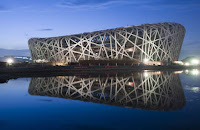 The year started off on a high with the very successful Vancouver Winter Olympics. We watched every-day Canadians challenge themselves and the world as they rose to become Olympians. Over 14 gold medals where bestowed on Canadians. While the snow was slow in coming it finally did and the winter raged on then turn to rain…lots of rain.
The year started off on a high with the very successful Vancouver Winter Olympics. We watched every-day Canadians challenge themselves and the world as they rose to become Olympians. Over 14 gold medals where bestowed on Canadians. While the snow was slow in coming it finally did and the winter raged on then turn to rain…lots of rain.The earth surprised us once again with its ability to literally shake us up with devastating earthquakes in Haiti & Chile. I also collected more scrabble words like “Eyjafjallajökull,” “Wikileaks”, “defriend”, “Glee”, and “Catastrophizing”.

In 2010 golf changed forever and so did Tiger Woods life. Oh another new word from Tiger was “priapsm”. You will have to look it up. You will also see it referenced in the advertising legal lines for Vigara. I digress.
The rains still came in summer. What summer you say. It never really appeared in Western Canada.
 We saw a number of corporate brands mismanaged and damaged such as Toyota, Oilsands and BP (Big Problem) and others who keep messing up our environment.
We saw a number of corporate brands mismanaged and damaged such as Toyota, Oilsands and BP (Big Problem) and others who keep messing up our environment.Another word that was overused this year was “Green.” Ever brand seems to be trying to wrap themselves with the latest green fashions. In my day, “going green” referenced what you wore once a year to the
 Irish pub. And in those terms, sustainability was also know as alcoholics.
Irish pub. And in those terms, sustainability was also know as alcoholics.There was also winning brands in 2010. Technology continues to drive the appetite for consumers with the likes of Apple with their new iPad, Blackberry (I am happy user) with its smart phones, Amazon with its Kindle e-reader (I have one and I love it!), Google with its Android smart phone, Facebook and the movie didn’t hurt the cause, and sadly
 McDonalds.
McDonalds.In difficult times this means that McDonald gets a second wind with
 people only able to afford a Big Mac as their main food souce. In contrast, Gold reached a new frenzy price of over $1,400. China continues to drive the market and sustain commodity prices. The USA is still trying to buy their way out of disaster. Will they succeed? If so, it will be short lived – as they will have to eventually pay for the surmountable damages.
people only able to afford a Big Mac as their main food souce. In contrast, Gold reached a new frenzy price of over $1,400. China continues to drive the market and sustain commodity prices. The USA is still trying to buy their way out of disaster. Will they succeed? If so, it will be short lived – as they will have to eventually pay for the surmountable damages.And I now find this long-winded blog coming to a close and wondering aloud, “how did I get to this point?” I guess a lot happens in a year and it’s important to reflect on it, not matter what.
Thank you for making 2010 another unique year. If I could wrap the year in to comment to pay homage, it would probably be in this short song:
“Ain’t no Eyjafjallajökull too high, ain’t no catastrophizing event too large for me to ever Wikileak your priapsm issues online with glee; as to defriend you, would be a tragic thing.”
Happy Holidays and a prosperous New Year.

















